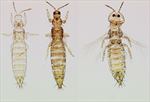
Female wing-length variants
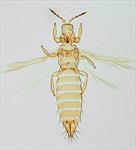
Female macroptera

Antenna
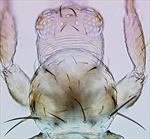
Head & pronotum
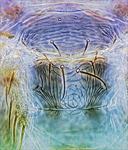
Meso & metanota

Meso & metanota and tergites I–IV

Tergites I-V
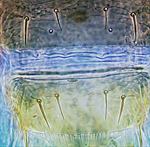
Tergites VII-VIII

Tergites VI–VIII
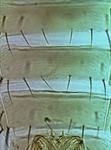
Sternites V–VII

Fore wing
Female fully winged, or more commonly, female and male with wings shorter than width of thorax. Body mainly yellow, abdominal tergites shaded medially, setae dark; antennal segments III–VII dark brown, II lighter, I white; fore wing pale with dark setae. Antennae 7-segmented; segments III & IV each with a short forked sense cone; segment VII slender. Head wider than long; 2 pairs of ocellar setae; pair III longer than side of ocellar triangle, arising lateral to fore ocellus; postocular setae pairs I & III shorter than ocellar setae III. Pronotum with 2 pairs of long posteroangular setae; posterior margin with 3 pairs of setae; three pairs of discal setae are larger than remaining discal setae, two near anterior margin and one near lateral margins. Metanotum with irregular reticulation; median setae arising behind anterior margin; campaniform sensilla absent. Fore wing first vein with 1–3 setae on distal half; second vein with about 10 setae. Abdominal tergite II with 3 lateral marginal setae; tergites II–III with median pair of discal setae at least half as long as median length of tergite; tergites VI–VIII with paired ctenidia, on VIII posteromesad to spiracles; tergite VIII posteromarginal comb complete, microtrichia long and slender; pleurotergites without discal setae. Sternite II with 2 pairs of marginal setae, III–VII with 3 pairs, without discal setae.
Male smaller than female; sternites III–VII with transverse pore plate.
The genus Thrips is the second largest genus in the Thysanoptera, and currently includes, worldwide, about 295 species. Amongst these species, T. nigropilosus is unusual because many adults of both sexes have short wings and particularly long tergal setae. All members of genus Thrips lack ocellar setae I on the head, and they all have ctenidia on tergite VIII posteromesad to the spiracles. Other characters, such as number of antennal segments, number of setae on the fore wing veins, and number of discal setae on the sternites are variable between species (Palmer, 1992; Mound & Masumoto, 2005).
Breeding on young leaves as well as in flowers, and although polyphagous, this thrips produces substantial populations on various Asteraceae including Achillea, Chrysanthemum, Lactuca (= Lettuce) and Tanacetum (= Pyrethrum). Pyrethrum crops in Kenya have been damaged by this species, also lettuce crops in Europe.
Originally from Europe, but now widespread around the world, including many States in USA between California and New York (Nakahara, 1994).
THRIPIDAE - THRIPINAE
Thrips nigropilosus Uzel
Thrips nigropilosus Uzel, 1895: 198
Thrips laevior Uzel, 1895:199
Thrips lactucae Beach, 1896: 224
Thrips umbratus Priesner, 1920: 59
Thrips pilosissima Priesner, 1922: 92.
Mound LA & Masumoto M (2005) The genus Thrips (Thysanoptera, Thripidae) in Australia, New Caledonia and New Zealand. Zootaxa 1020: 1–64.
Nakahara S (1994) The genus Thrips Linnaeus (Thysanoptera: Thripidae) of the New World. United States Department of Agriculture. Technical Bulletin 1822: 1–183.
Palmer JM (1992) Thrips (Thysanoptera) from Pakistan to the Pacific: a review. Bulletin of the British Museum (Natural History) Entomology Series 61 (1): 1–76.